|
|
|
|
This Just In...News
From The Agony Column
|
|
Preview for Podcast of Monday, April 2, 2007: Raisins d'etre.
Here's an MP3
preview of the Monday April 2, 2007 podcast for The Agony Column.
Enjoy!
|
|
03-30-07: Randall Silvis 'In a Town Called Mundomuerto'
|
Don't Stop Me If You've Heard This Before
|
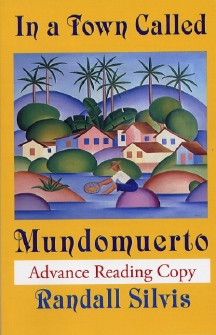
|
You've
been there. You are there.
|
As I read 'In a Town Called Mundomuerto' (Omnidawn ; June 18, 2007
; 412.95) by Randall Silvis, I kept slipping back, to another time
and another
place. Had I been in a town like that described by the author? Not
that I knew of, though it reminded me of some places I'd vacationed
with my
parents as a child, the little fishing villages in Mexico where we
used to tow our 12 foot Boston Whaler. The images the book created
in my mind
brought back those sun-drenched lazy days. Or perhaps I had read
another, similar book. But that wasn't it either.
From the moment I picked up the book, the language seemed to flow from
places I'd been, from words I'd read, from a world I'd lived in. 'In a
Town Called Mundomuerto' has the ring of myth, the feel of legend, the
sound of song you once loved but somehow lost. Language is magic, this
book says, though those words never appear. Let me speak to you and tell
you a story I know, one you know as well.
The story has played in our world a thousand times, a million times.
It is happening right now. An old man tells his grandson a familiar
tale.
It is a story the grandson has heard often enough that he is able to
correct his grandfather's staying rendition. Perhaps that's why the
book feels
so comfortable, so familiar. In the village of Mundosuave, now called
Mundomuerto, there lives a beautiful young girl named Lucia Luna. She
is loved by all
men, yet loves none of them; sell perhaps Alberto, a little though
she uses him badly. He plays his guitar for Lucia, but when Arcadio
Martín
arrives, it is he she chooses, even though he is a dolphin-man. Or
perhaps something else.
Silvis is an intuitive writer, the sort who seems to be mapping a terrain
that short-circuits realities both actual and imagined. 'In a Town Called
Mundomuerto' is very compact -- a mere 155 pages -- yet it creates a world
as complex as the real world, re-imagined. Ever y word seems carefully
chosen, every scene, every line of dialogue seems pre-ordained, pronounced
before the world was born and simply waiting for Silvis to free them on
paper. Silvis writes a perfect fable of identity and love, of how they
create one another, challenge on another and perhaps, destroy one another.
The words here fall as polished jewels.
'In a Town Called Mundomuerto' reminded me of nothing I could precisely
remember, but evoked feelings created by other books I'd read. I flashed
back to my youth when I bought and devoured 'Bullfinch's Mythology',
to the time I read China Miéville's 'Perdido Street Station'
through an entire night awake when I took my son and the Cub Scout
den to stay
on a de-commissioned aircraft carrier. It is poignant and powerful,
simultaneously obscure and familiar. The novel is as much a shape-shifter
as those creatures
within it, a dream of flapping wings, a glimpse of a shape and a whisper
of sound. It's a story you've heard or a story you've told. You may
have lived in this town. It reminds me of this very morning, when I
stood in
the dark halfway up a flight of stairs that lead up from the beach
or down to the beach. Which way was I traveling? The moon, bloated
and yellow had
just dipped below the horizon. The sun was nowhere to be seen. A faint
dust of stars stretched from the lights across the bay.
|
| |
|
03-29-07: Kim Deitch 'Shadowland' and Stephen
King's 'The Secretary of Dreams'
|
Anxiety, Illustrated
If only we knew
how to externalize our anxieties. How to illustrate our fears.
Yesterday, I wrote about big books, as in big, thick books. But thick doorstoppers
aren't he only kind of big book out there. Readers might recall a couple
of weeks ago, when I first encountered Kim Deitch's 'Alias the Cat'. Upon
publishing the article, I wrote the Deitch, and he had his Fantagraphics
crew send me their latest, the incredible 'Shadowland' (Fantagraphics ; March
29, 2007 ; $18.95) and it is indeed a treat. Deitch told me in an email that
he was interested in pursuing more illustrated text-style work as opposed
to the pure graphic-novel form we find here. Coincidentally, or not, I just
managed to lay my hands on the well-worth-your-time-and-money big book by
Stephen King, 'The Secretary of Dreams: Volume One' (Cemetery Dance Publications
; October 30, 2006 ; $75). Sure, it is a tad pricey, but look what you get:
no less than six short stories by Stephen King; three as heavily illustrated
texts, three done in straight-up graphic novel style, with the wonderful
artwork of Glen Chadbourne. And yes, these two books are precisely the same
size. It's a whole new kind of big book-o-rama.
|
|
|
Scream
/ Press and JK Potter illuminate King circa 1985. |
|
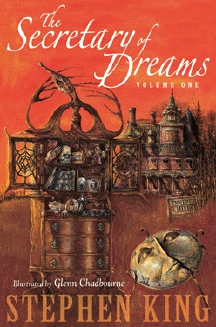
|
Chadbourne
& King.
|
Let's start
with the King, because illustrated Stephen King short stories and I
go back a
long ways. None of this newcomer, ooh-la-la stuff here. Lets roll back
to 1985.
Great music, and the dawn of Scream / Press with their ultimate,
illustrated by JK Potter edition of 'Skeleton Crew'. I know that "The
Mist" is now in production, but I just hope it will look half as
eerie as Potter's photomontages for this deluxe volume.
That book was
one half of a perfect pair -- matched by the omnibus edition of Clive "the
future of horror" Barker's 'Books of Blood', also from Scream /
Press -- that set the standard for me so far as to how and why books
should be illustrated.
A mere TWENTY ONE years later, let's jump on the
overcrowded but still vital Stephen King bandwagon to celebrate 'The
Secretary of Dreams', which includes two stories from 'Skeleton Crew', "Uncle
Otto's Truck" and "The Reach", both illuminated by Glen
Chadbourne.
|
|
One
of these images remotely resembles the author. |
Now I've mentioned
Glen here before. His illustrations for 'Bloodstained Oz' by Christopher
Golden managed to match Golden's excellent work.
Here, we have Chadbourne stretching himself and finding strengths those
of us who
have been watching him have long known were there. 'The Secretary of
Dreams' is a large book, 12 3/8" by 9 3/8". It offers first an illustrated
version of 'Home Delivery', King's creepy contribution to the infamous /
famous Mark V. Ziesing published 'Book of the Dead', edited by John Skipp
and Craig Spector. You know, the collection of short stories set in a post-Romero
Night of the Living Dead world. There were a couple of stories in there that
at the time were seen as being beyond the pale. Times change, eh? Now we
can watch 'em empty the contents of someone's stomach five nights a week.
Next up in this book is "The Road Virus Heads North', given a
gritty, grim graphic novel treatment. As a graphic short story, the
artist has and
takes the unprecedented opportunity to illustrate the main character
as looking suspiciously like a rather well-known author.
Next up is one of my all-time
favorite King stories, "Jerusalem's Lot" a prequel of sorts
to 'Salem's Lot', but more importantly in my eyes, an very well-done
piece of
Lovecraftian fiction that does the neat trick of turning vampires,
which Lovecraft loathed as monsters into a Lovecraftian menace. Cool,
and MUCH
cooler with Chadbourne's illos and the not-yet-mentioned giant font,
super easy to read typeface. I know I'm getting old, but hell, this
just makes
reading a pleasure and better enables me to immerse myself in the reading
experience. "Rainy Season" gets a dreamy, monsterific graphic
short story treatment. Chadbourne's style is to my mind, kind of furry.
It's rich
with detail and there are panels in this story that you can gaze at
for hours. Is it better to see your dreams made real in Chadbourne's
illustrations?
Well, that depends; I think it's certainly nice if you've already read
the story. It allows you to experience the story anew. If you've not
read the
short stories adapted graphic-style here, then it's probably not a
bad idea to read them that way first, then read Chadbourne's adaptations.
After all,
if you shell out $75 for this, you don’t want to gobble it all
up in a night, as tempting as that would be. The final two stories
are an illustrated
version of "The Reach" and a graphic-story adaptation of "Uncle
Otto's Truck", bringing us full circle to 'Skeleton Crew', where
I first read both of them.
Now $75 might seem a bit steep, but frankly it's really rather cheap
for such a finely produced book. It comes with a nice slipcase and
if you're
just bubbling over with cash, you can get an edition signed by King
and Chadbourne. Please email NPR and tell them to hire me full-time
to do interviews so that
I may aspire to such riches. In the interim, I'll make do with the "Gift
Edition" and it is a gift -- to readers.
|
|
...more
anxiety for you. In you. From you.
|
Speaking of which, let's jump tracks to Kim Deitch's 'Shadowland' a
graphic novel that is probably creepier and scarier than 'The Secretary
of Dreams/
and at $18.95, a lot cheaper. Still, you have to hand it to Fantagraphics
for giving readers an amazingly well done volume, both in terms of
production and print quality as well as in terms of Deitch's own twisted,
peculiarly
brilliant storytelling skills. 'Shadowland' is a 9" by 12" trade
paperback (sort of) with thick-stiff, colored covers and a full-color
gatefold poster at the end of the book. Before that ...
Before that, you'll find ten very twisted short stories that span a
century of ill attitudes, featuring as narrator and background character
the sleazebag
carnival owner of your nightmares, Al Ledicker. What makes Deitch's
stories remarkable and disturbing is his ability to create characters
we care about
and his willingness to put them through travails that will make readers
cringe with terror while they shiver in delight. Take for example,
the story "No
Business Like Show Business". Toby the Flying Pig earns our love in
Deitch's creepy carnival even as he heads towards ... dinner. Deitch deftly
combines a simple, powerful illustration style with lots of disturbing grace
notes to create a dissonant symphony of triumph and tragedy. What’s
more, in the introduction to the book, he tells us why all his clowns look
like John Wayne Gacy's clowns. You may or may not wish to know this, depending
how important a good night's sleep is to your constitution. "The Strange
Secret of Molly O'Dare" is a frightening exercise of Deitch's meta-fictional
style. The author inserts himself into the narrative in true transrealistic
style, then goes off to spin a tale by "Fowlton Means" that does
fine job of making the connection between the "little Folk" often
seen as malevolent fairies and spaceship aliens that kidnap humans
to perform unspeakable experiments upon them.
|
|
I
LOVE aliens and fairies. Totally fortean!
|
Deitch is not averse to using pseudo-erotic storylines to ratchet up
our fear level to unprecedented heights, so I'd caution anyone who
were to think
this might be an appropriate book to give a teenager or girlfriend.
Read it first before you make that decision, but by all means read
it. Deitch
deftly makes use of stories within stories to create a distance that
enables readers to wrap their brains around the some of the more horrific
implications
of what unfolds within. And taken as a portrait of the last century?
Well, one can say only that I'm glad we're out of it, but knowing that
Deitch is
already preparing to give the current century a going-over, I can't
say I'm thinking we'll be much better off. At least we'll have that
document to externalize
those deep fears.
To illustrate our anxieties.
|
| |
|
03-28-07: David Anthony Durham and Patrick Rothfuss
Are Heavyweights
|
Are Giant Fantasies Worth Your Reading Time?
 |
|
| Oooh.
Blurry clip art buried in leaves. Impressive. More so than
the usual "Do you like gladiator movies?" style but still...get
a clue! |
When you pick up a book and start to read it, you're making an investment
of your most valuable asset: time.
You have nothing else.
Your loved ones, your family, your career, they all deserve your time.
What precious little you have left needs some keen decision-making when
you apportion it.
Let's presume that you've concluded that reading is your best entertainment
investment because it requires a creative act on the part of the reader.
You have to manufacture the worlds you read of in your mind, and by
virtue of that creative act, they become more real and involving than
other forms
of entertainment that impose their worlds upon you. But now that you've
decided to read, you got these books in front of you. And if you decide
to read a 416 (possibly 592)-page novel, or a 652-page novel, you want
to be sure that your valuable time is going to be well spent. I see
a lot of fantasy come over the transom, and while most of it seems
serviceable
so long as you’re not too picky, I am VERY picky. I've spent
most of my life reading and I've developed a reading radar that feels
fairly
finely tuned. Two fantasies that recently arrived seem to offer rather
different but both potentially satisfying reading experiences that
make them potentially Worth Your Valuable Time. They are, however,
rather different
and one or the other may be more or less suitable for readers of varying
inclinations.
The first book to land with a "THUD!" was 'The Name of the Wind:
The Kingkiller Chronicle: Day 1' (DAW Books / Penguin Putnam ; March 27,
2007 ; $24.95) by first-time author Patrick Rothfuss. And they will be
making a fuss about him, have no doubt about it. And it will, to a certain
very large segment of readers, be quite worth the fuss and the valuable
time as well. It's an elegantly written first novel, a sort of autobiography
of a hero, richly detailed, providing readers who like to get lost in their
fantasy with all the glorious details of the life of Kvothe ("pronounced
nearly the same as 'Quothe'"), who charts a not-unfamiliar course
from street urchin to magic school student.
By keeping things in the first person, Rothfuss gives the novel an immediacy
that's often lacking in large-scale fantasy. Rather than having the epic
events handed to you on a platter, they're related to you as if your pal
Kvothe is sidling up to you and angling for pint in return for the latest
chapter of his epic tale. He also gives it a lot of personality and the
sort of matter-of-fact authenticity that makes the unreal seem very real.
Humor is here as well, with a wry sense of observation that never gets
silly. Rothfuss wisely leaves silly to the pros; but one can always, as
it were, just look around.
'The Name of the Wind' utilizes a nice framing device to ease readers
into the story, but once we're there, the author's sense of putting
readers
in a created world is so sure and certain you won’t realize just
how fantastic (in terms of "the fantastic" not simply quality)
the surroundings are. Rothfuss does not go out of his way to offer the
sort of grotesqueries one might find in other worthwhile fantasies. Instead
he concentrates on crafting a remarkably consistent prose voice that makes
the world it describes seem as real, yes, even more real than the world
around the reader. As Kvothe's story unfolds, expect to enjoy a rip-roaring
plot that will actually hold your interest for the door-stopping 652 pages
that this installment needs. Yes, I said installment and "Day One" refers
to the length of time it takes to tell the story, not the time over
which the story stretches. This is a foundation stone, a cornerstone,
a brick,
the first of three. Of course it's a trilogy. Assuming that Rothfuss
delivers the next chapters in a timely manner, we may have a real winner
here, someone
who can tell a story that is compelling without being too heavy-handed.
If you like any of the exemplars of current fantasy that pop up in
the bestseller lists, then you owe it to yourself to give this one
a try.
|
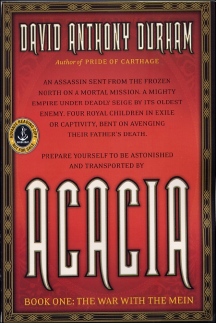
|
This
ARC cover is better than the actual cover.
|
David Anthony
Durham's 'Acacia: Book One: The War With the Mein' (Doubleday / Random House
; June 19, 2007 ; $26.95) takes a rather different but
equally successful tack to achieve "Worth Your Valuable Time" status.
Durham is the author of three well-received historical novels, 'Gabriel's
Story', 'Walk Through Darkness' and 'Pride of Carthage'. The first
was a story of the wild, wild west, told from the perspective of emancipated
slaves; the second a tale an escaped slave's journey through antebellum
America; the third, a full-blown elephants-and-spears epic of Hannibal's
march over the Pyrenees and eventual defeat before the forces of Rome.
It's germane to mention that Durham is black, as that informs the multi-racial
cast of characters and the sweep of 'Acacia'. Again the setup is fantasy
classic, though damnably clever. Leoden Akaran rules over an empire
at
peace but mired in corruption and founded on evil. Not an evil man
himself, when the Mein, barbarians from the frozen wasteland, start
a war, Leoden
decides to finish it in a manner that will see his children survive
to inherit an empire based on freedom.
Durham's novel bristles with the joy and power of a historical novelist
freed to create his own history. This is not the typical history of
fantasy novels, though Durham assures us that he is quite familiar
with all my
favorites -- Gaiman, Herbert, Stephenson. What informs this novel and
sets it apart is what made 'Earthsea' so special, a fully realized
world of
humans as varied as the usual elves, dwarves and whatnots. Well that,
and an immense writing skill that brings a literary flair as well as
lots of
excitement to the novel. Durham displays a deep sympathy for all of
his characters. There are no simple sides to be taken here, and there
are no
simple quests. The solution to the problems of the world he creates
lie in its undoing and re-doing. This involves political as well as
military
moves, the delicate ballet of give-and-take diplomacy. But fantasy
readers hunger, I think, for reading that offers the forge of imaginative
creation
melded with knowledge of the workaday world. For fantasies that regard
our world with a steady, true eye, and then recast it in a manner that
makes everything seem utterly, believably mundane and yet sparkle with
the splendor of a vivid imagination. Having spent some time world-building
our world for his first three novels, Durham's ability to create a
new one out of whole cloth is not surprisingly quite strong. 'Acacia'
becomes
a world the reader can visit independently of the events in the novel,
a place you can tool about in your mind.
While I'm glad to see that neither novel sports a cover featuring muscle-bound
swordsmen slicin'-n'dicin' an angry dragon while a buxom babe hangs
breathlessly (and for the most part, clotheslessly) in the background,
I do think the
publishers could do better than what looks like blurry clip art. It
just can't be that expensive to hire someone like J.K. Potter, John
Picacio,
or Edward Miller to give readers a better idea of what to expect inside.
And I suspect that the reward for the publishers would be significantly
higher. I don’t even know if readers will be able to suss that
either of these is a fantasy when they trip over them in the bookstore.
Maybe that's the point and it's not a bad one, but there are some reasons
to take care with your covers. But by all means, readers should go
to a bookstore and check them out.
Of course, for both of these novelists, the challenge they set for themselves
is quite high. We've seen many a promising beginning bloat in every direction
other than a satisfying ending. Both of these novelists promise us a trilogy.
I would gladly jump from three bridges if writers were willing to declare
a ten-year moratorium on the T-word. But if they promise one, they'd best
deliver, and one hopes, not a trilogy for which the final volume is the
equivalent of four first volumes. These novels are indeed worth your valuable
time. I look forward to more time, well-spent reading. When investments
in reading pay off the dividends are more lives, more life than the minutes
spent reading. We live lifetimes when we create those worlds in our minds
as we read. We'll fight to save those lives.
|
| |
|
03-27-06: Muscle Girls
|
Justina Robson and Steph Swainston Show Their
Strengths
 |
|
| Now
in US bookstores. Thanks, Lou and Justina! |
Anytime you think
you can corral writers or a genre into a neat little corner, someone
comes along and tramples down every
damn fence you've got.
Here at The Agony Column, we've been covering two writers who have
been doing that from the get-go, and now that both have
new work out, it's time
to saddle up and get with the program. Justina Robson first
caught my attention back in the before-time with 'Silver Screen',
a trade
paperback original
from Pan Macmillan that came out sometime in the vicinity the same
publisher first unleashed Neal Asher on an unsuspecting
world. And Steph Swainston followed not
too long after Victor Gollancz opened the door for Richard Morgan.
If I bring up these manly-men / brutal-monsterific authors
in concert with the lovely ladies, well there's a reason.
Robson and Swainston have
just as much muscle and verve (and violece and monsters) in their
work as do Morgan and Asher. Now, given, none of them are particularly
similar
in
subject
or even execution.
But they’re all bristling with energy and right up in your
face with a combination of inventive innovations and the sort of
joie de
genre that
makes readers willing to read such fiction thrilled to their fingertips.
The latest salvoes are in from Robson and Swainston, and they're
just rockin' good. Here in the states, readers can grab a hold of
the first
book in
Robson Quantum Gravity Series, 'Keeping It Real' (Pyr / Prometheus
; March 20, 2007 ; $15). I covered this when it first came out in
the UK from Victor
Gollancz last year. Robson's series posits that a "Quantum Bomb" in
the year 2015 shreds reality almost as effectively as her great genre fiction.
Blink and you've got elves, daemons and elementals and their various universes
to assimilate into our world. It's not going so well, but some folks are
keeping it real, and making a bit of coin in the process. Elves of course
make better rock stars than vampires, and they need a bit of bodyguarding
from a leather-clad, stone fox, half cyborg warrior named Lila Black, don’t
they? Robson is a seasoned pro at this point, and she knows how to
have fun.
|
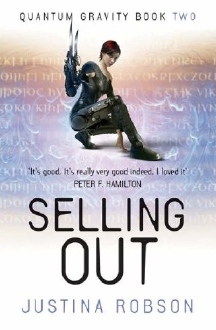
|
Queued
up and ready to go; thanks to Simon and Justina.
|
So much fun that
readers who gobble up the Pyr novel will be oh-so-glad that they can
snap up the future now in the form of the sequel, coming
soon from none other than Victor Gollancz. That would be 'Selling
Out' (Victor Gollancz / Orion ; May 2007 ; £18.99 (HC) £10.99
(TPB)), a sequel that does anything but live up to its title. We'll
elide details
of the upshot of events in 'Keeping It Real', and instead suggest
what comes next. Nothing less than a visit to one of those realms
opened
up by that pesky Quantum Bomb back in the day, in this case, Daemonia.
You
can imagine that a gal like Lila Black can get into some trouble
over in a parallel universe nicknamed Hell. But even Lila's imagination
is challenged.
Yours is simply sent into spec-fic overdrive, with all manner of
wild
doing described by a writer who is having nearly as much fun as her
readers.
To my mind, this is the sort of series that should shoot to the top
of the SF bestseller list and indeed deserves a shot on the mundane
bestseller
lists as well. Look, if already past-its-sell-date girly PI fiction
can top that stupid list, why can't something much more exciting
do so as well?
It's down to distribution and initial print runs of course. But word
of mouth can do the trick as well. So read, enjoy and let everyone
else in
the damn store know that they should be reading these book as well.
After all, it is the 21st century? But the friggin' bestseller list
is barely
inching into the 1980's and the fiction there just pales to the music
of the 80's. Let's get our bestseller list in sync with the times.
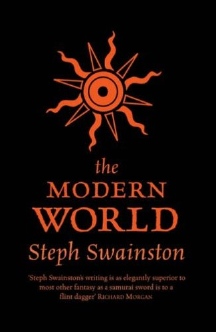 |
|
| I
miss the Edward Miller covers. |
And don’t think I've forgotten about Steph Swainston. She's the author
of 'The Year of Our War' and 'No Present Like Time', and her new novel
set in the world of the Fourlands is 'The Modern World' (Victor Gollancz
/ Orion Books ; April 2007 ; £10.99 (HC) / £9.99 (TPB)).
Swainston's fantasy is pretty different from almost anybody else
out there. She combines
a surreal visionary prose style with some realistic gritty description
and characterization to create a feel that is unlike just about anyone
else out there. Her approach is jagged and not always easily assimilated,
and her characters are not easily sympathetic. Jant is a drug addict
and a voluptuary. But he's your guy and he's your guide to the utterly
bizarre
world of the Fourlands, where immortals and humans find themselves
battling Insects that only begin to be described by the world alien.
'The Modern World' serves up two unpleasant choices for Jant. On one hand,
he's got Frost, the architect of the Circle of Immortals, with her plan
to win once and for all the war with the Insects. Oh sure, maybe it involves
a surge. But terror wrought small also beckons, in the form of Cyan, the
daughter of Jant's friend Lightning. Gone missing, has she? Seventeen going
on twenty-seven, hotter than hell and twice as tempting? Probably not a
good match for Jant's location skills which trend towards the hands-on
approach, an approach that Lightning will frown upon, to say the least.
So, ultimate weapon versus intimate friend. No good choices there, but
for the reader. The reader has the pleasure of immersion in one of the
most unique and odd universes you'll ever encounter. Swainston's prose
has the kind of density that allows her to truly a build a world so alien
that you can't quite grok it, but you sure as hell can enjoy it.
What you can't do with either of these writers or their works is
easily categorize them. Are they "sci-fi"? I can barely
make myself type that bastardization, but there you go, I do it for
just to deny
that they are simply that. They're weird all right, really weird.
Fantasy? No
poofters in billowy sleeves here! No sword-wielding weenies either!
Just some tough as nails gals and guys, scrabbling in the hard dirt
of invented
realities. Invented, I might add, by women who defy your puny attempts
to categorize them, but invite you to read their work. Who needs
a crappy movie when you can play one of these stories in your brain?
Don't try to
corral these novels. Or if you do, just categorize them in that completely
undisciplined and indefinable world of books you bought and enjoyed
the hell out of. You know, I do believe that the Quantum Bomb may
be
necessary
to get the bestseller list aligned with the literary irreality of
the 21st century.
|
| |
|
03-26-07: A 2007 Interview With James D. Houston; A Review of 'Bird
of Another Heaven'
|
"This is
who we are and this is where we come from"
|
 |
"I
had a similar experience in my own life."
|
On the first page of James Houston's new
novel, 'Bird of Another Heaven', we encounter the last King of Hawai'i,
Kalakaua, in the Palace Hotel
in San Francisco, on what would prove to be his deathbed. A representative
of the Edison company has come to demonstrate to the King an incredible
new technology that will allow him to record his voice on a wax cylinder. "At
the time I first heard the story," Houston says, "it came with
a kind of context of conspiracy theory...Do we really know what the King
said on that wax recording?"
'Bird of Another Heaven' plumbs that mystery and finds layers of generational
family stories that stretch from the Sacramento River Delta to the shores
of Hawaii. His story starts in 1987, with Sheridan Brody, a talk-show
radio host who finds that he has a grandmother he never knew, and beyond
her, a great-grandmother who may have attended the King in his final
hours as his voice was recorded for posterity. "The central character
in this novel," Houston told me in our interview, "is Nani
Keala, who is half Hawaiian and half California Indian. She was born
in the Sierra Nevada foothills in the 1860's, and ended up having an
extraordinary life, an almost mythic life. I had to develop a character
who is the narrator of the novel who is the great grandson of this woman,
and he discovers in the midst of his life a part of his family legacy
that was kept out of sight by his parents. I had a similar experience
in my own life. My grandmother, who was a very sweet Tennessee mountain
fundamentalist Christian lady, born in the Appalachians in the 1880's
moved down to Huntsville Alabama in 1900, and she married a guy who was
half-Indian, half Cherokee. But I didn't find out about this for a long
time."
Houston's novel is an intimate epic, exploring the complexities of families
and generations as California rises and Hawaii falls. I was fortunate
enough to speak with Houston last week, and I'm podcasting the interview
this week, as the novel launches. Houston has an outstanding voice both
in prose and in person. Each is powerful and deep, and Houston himself
is a fascinating writer. He simply trusts in the process of writing,
and the results show that trust is well-deserved. Readers can hear the
MP3 of the interview, or a RealAudio
version. Once you hear him speak,
prepare to buy the novel. You'll want to hear that voice in prose.
|
"This is
who we are and this is where we come from"
 |
|
| Book
of another heaven. |
'Bird of Another Heaven' explores little known histories in both Hawaii
and California. I'm
posting my in-depth, spoiler-free review of it here.
But I do want to add a bit more to that review, based on my conversation
with the author.
One of the highlights of the novel is Houston's evocation of General
Sutter and the birth of Sacramento. "Only a couple of explorers
had preceded him and left behind very sketchy maps. He was sailing into
a world of tribal villages with six white sailors and ten Hawaiians.
The truth is that the first buildings that were erected at what is now
the capital of the biggest state in the United States were Hawaiian grass
houses."
The ties between Hawaii and California are offered not just on a grand
scale, but in terms of complex characters intimately explored. "I'd
been fascinated with Kalakaua for a long time because he was a man of
extraordinary talents and huge appetites." Those appetites were
used by his enemies to help bring about the collapse of the Hawaiian
empire–with the aid of some handy Marines, who helped to craft
what was called the "Bayonet Constitution." Kalakaua traveled
the world, and in 1891, fell ill in San Francisco. But before his death,
he brought about a rebirth of the Hawaiian culture, which had been systematically
erased by three generations of missionaries. When he was elected King,
he single-handedly brought back the ancient traditions of the hula dance,
long condemned as obscene. "The rebirth of Hawaiian culture begins
with Kalakaua's coronation, when he said to the missionaries and all
these uptight conquistadors who were trying to take over the islands,
he said, 'This is who we are and this is where we come from.'"
|
| |
| |
|
|















